SOFWERX Tech Tuesday is searching for groundbreaking and transformational capabilities.

Submit yours today at www.sofwerx.org/techtuesday.
SOFWERX Tech Tuesday is searching for groundbreaking and transformational capabilities.

Submit yours today at www.sofwerx.org/techtuesday.
Catalyst Accelerator’s (Catalyst), Cyber for Space Applications, launched eight small businesses into the reaches of the U.S. Space Force, with its sixth accelerator Demo Day on November 19, 2020. Powered by Air Force Research Laboratory, Space Vehicles Directorate and sponsored by Booz Allen Hamilton, the cohort of small businesses concluded its 12-week accelerator, gaining traction into moving technology from commercial application to the military warfighter.
Cyber applications have long been the mainstay in the Department of Defense, but with the creation of the U.S. Space Force, a rigorous hunt for disruptive cyber technology has begun. No longer is the warfighter confined to air, land, sea and cyber. Space is now a contested domain, with near-peer adversaries with comparable capabilities, unsettling operations in both the public and private sectors. U.S. data exfiltration by malicious actors is staggering. In 2019 it was estimated that 6.5 million documents per day were stolen by U.S. adversaries, according to keynote speaker Brigadier General D. Jason Cothern, Vice Commander of Space and Missile Systems Center.
The U.S. Space Force is tasked with protecting America’s interests in space, deterring aggressive acts and sustaining operations in this far-off region. With this in mind, Catalyst’s Cyber for Space Accelerator invited small businesses to apply to become a cohort company and demonstrate how their technology might “secure the next generation of space operations and increase resiliency.” “We had a team of 19 people that helped us choose the best companies for this cohort and judging from the response of subject matter experts from Industry and the Department of Defense over the course of the Accelerator, our selection was excellent. I look forward to these companies gaining the traction they need to get their technologies into the hands of the United States warfighters, making the cyber-physical systems they rely on more relevant and secure in the 21st Century fighting domain!” says KiMar Gartman, Program Director of Catalyst Accelerator.
With the support of LinQuest, the platform sponsor, the twelve-week all-virtual accelerator helped cohort companies mature their messaging, understand the government space and pivot their technology to meet the needs of the warfighter. The cohort received guidance from industry and government Sherpas and subject matter experts like Pikes Peak Small Business Development Center; spoke to operational warfighters to determine their needs; were instructed on the acquisition process; and began building relationships with key personnel interested in their technology. Gentry Lane, CEO and Founder of ANOVA Intelligence explained her experience with Catalyst’s accelerator, “I’ve been through other accelerators but Catalyst was different.
They absolutely delivered on their promise to connect us [cohort companies] with people in the U.S. Space Force that make decisions about purchasing and using our technology.”
Demo Day, sponsored by Lockheed Martin, was the Accelerator’s culminating event in which government and industry scouts learned about the cohort’s dual-use technologies that will disrupt space cyber and place the U.S. in an even better position to dominate space. Cohort companies rose to the challenge and presented technologies that will improve warfighter capability today and well into the future. The cohort company pitches can be viewed at catalystaccelerator.space/cacsa
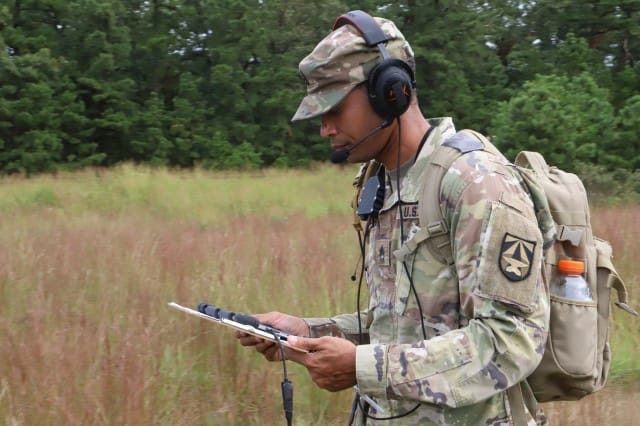
WASHINGTON — The Defense Digital Service is a team of 82 engineers, data scientists and computer scientists, working on some of the hardest problems in the Defense Department.
Brett Goldstein, DDS director, said they’re a “swat team of nerds.” He spoke remotely today to the Center for a New American Security in Washington, D.C.
A big advantage of DDS, he said, is that it reports directly to the secretary of defense.
That means the team is able to quickly answer the call if any tech issue arises. He also said that they could work on large projects rapidly when needed.
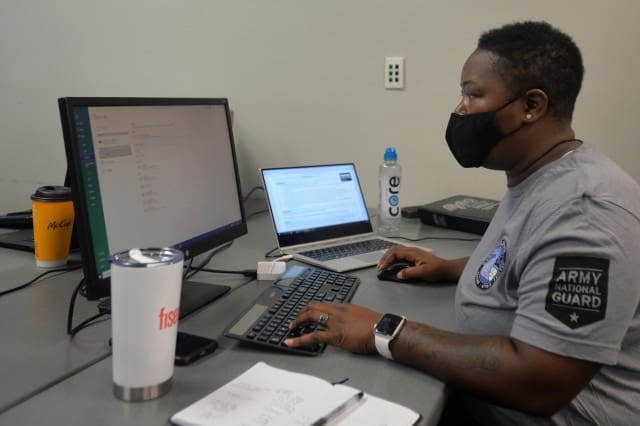
DDS has worked on the much-publicized “hack the Pentagon” program, which looks for vulnerabilities in the department’s information technology systems and comes up with ways to fix them, as well as to improve software and hardware.
Currently, DDS is partnering with the National Security Agency to cyber-protect Operation Warp Speed’s search for a COVID-19 vaccine, he said.
DDS has also partnered with the medical community to develop COVID-19 symptoms checkers, which DOD personnel and their families can use to figure out if they need to get medical care, he said.
Another important ongoing program is the counter-unmanned aerial systems initiative, which addresses the problem of being attacked by swarms of small, hard-to-detect unmanned aircraft systems. Goldstein said that a rapid response team is on standby to fly out to remote areas should the problem arise.
For example, when the USNS Comfort and Mercy hospital ships were aiding in the COVID-19 effort, DDS personnel were helping to ensure small UAS were not being used to attack them.
DDS is also working with the Joint Artificial Intelligence Center to advance AI and machine learning, he said.
Most DDS employees recruited are civilians coming for two- to four-year terms, from the Silicon Valley world. The selection process is very rigorous, he said, because those who are selected will be working on the hardest problems in the department.

Goldstein said the team members are given the most “wicked” projects to work on and they’re okay with that because “engineers love challenges.”
Some advice Goldstein has for information technology leaders in the department: “We need to sometimes talk a little less and execute a little more. Sometimes we’ll be dead-on and sometimes we’ll fail, learn from the failure and then be okay with the failure and just try again. Like that’s the type of environment we need to encourage. Americans are innovative. We need to foster that innovation here.”
By David Vergun, Defense.gov
WASHINGTON (AFNS) —
Less than 200 personnel assigned to the Department of the Air Force Rapid Capabilities Office rapidly develop capabilities to outpace and counter the increasing threats of adversaries.
Their primary focus incorporates cutting-edge approaches to standard acquisition processes to produce capabilities for both the Department of Defense and the DAF, which includes the U.S. Air Force and the U.S. Space Force.
The mission of the DAF RCO is to expedite development and fielding of select DoD combat support and weapon systems by leveraging defense-wide technology development efforts and existing operational capabilities.
“Built on using speed and efficiency, we expedite the fielding of critical capabilities to the warfighter,” said Randy Walden, director and program executive officer for the DAF RCO. “This includes operators in both the United States Air Force and the United States Space Force in support of the National Defense Strategy.”
Originally activated in April 2003, one of its first projects was to deploy significant upgrades to the Integrated Air Defense System, now operational around the National Capital Region, to meet critical counter-terrorism objectives before the January 2005 Presidential Inauguration Day.
Today, the DAF RCO portfolio includes several high priority developmental and experimental programs.
For example, the X?37B Orbital Test Vehicle program is an experimental test platform that supports the U.S. Space Force to meet DAF objectives. Space Professionals conduct X-37B launch and on-orbit operations, and the DAF RCO program office team will include Space Force members as the new service continues to stand up.

The X-37B is an experimental test program to demonstrate technologies for a reliable, reusable, unmanned space test platform. The primary objectives of the X-37B are twofold: reusable spacecraft technologies for America’s future in space; and operating experiments, which can be returned and examined on Earth.
Currently, the X-37B is conducting on-orbit operations in its sixth mission.
The DAF RCO is also home to the B-21 Raider program. The B-21 is a U.S. Air Force priority, which will provide critical operational capability and flexibility across a wide range of military objectives, providing both conventional and nuclear capabilities in fulfillment of national objectives.

The B-21 is being designed to be highly survivable with the ability to penetrate modern air defenses to strike any target, anywhere on the globe in a contested area of operations.
The program plans to deliver the first B-21 aircraft to operational bases in the mid-2020s.
“The DAF RCO is a unique organization because it supports priorities for both the Space Force and Air Force,” Walden said. “The office is staffed with a variety of functional DAF specialists who form a collaborative melting pot of expertise built specifically to operate within the gray areas of the standard acquisition processes.”
The DAF RCO conducts streamlined acquisitions in response to Air and Space Forces and Combatant Command requirements. It reports directly to a board of directors comprising of the Under Secretary of Defense for Acquisition and Sustainment; Under Secretary of Defense for Research and Engineering; Secretary of the Air Force; Assistant Secretary of the Air Force for Acquisition, Technology and Logistics; U.S. Space Force Chief of Space Operations; and Chief of Staff of the Air Force.
“Whether it’s digital engineering, prototyping or modern software development, the DAF RCO is committed to advancing the capabilities of the Department of the Air Force,” Walden added.
By Secretary of the Air Force Public Affairs
Manager – Expeditionary Support (PM-ES), will conduct an Austere 3D Printing Assessment Event (AE) to identify 3D printer capabilities designed to meet the unique requirements of Special Operations Forces (SOF) Operators in austere environments.

Current U.S. commercial off-the-shelf (COTS) 3D printers are not designed to meet the unique SOF requirements (i.e. size, weight, power, mobility, survivability, etc.) needed in support of USSOCOM SOF missions.
the USSOCOM MTRC program is interested in assessing 3D printer technologies ranging from small – single SOF Operator portable systems with niche capabilities that can be hand-carried and/or transported via non-standard commercial vehicles, to moderate – SOF Team portable systems with robust adaptive manufacturing capabilities that can be palletized and/or transported by C-130 aircraft.
They desire the following system attributes:
-U.S. 3D printer technologies designed, developed, produced, manufactured, and/or supported predominantly in the United States.
-U.S. 3D printer technologies that are self-contained, ruggedized, mobile, and capable of printing at SOF point of need in a wide array of environmental conditions.
-U.S. 3D printer technologies that allow for forward deployment, into the field, at the point of SOF equipment failure, reduce hardware replacement times, enable SOF Operator innovation, are reliable, and/or are easy to operate and maintain.
Interested parties must submit, NLT 30 September 11:59 PM ET. Visit events.sofwerx.org/3dprint for full details and to enter.
WEST LAFAYETTE, Ind. — Every time a gun fires, lead leaches into the air. A scientific advancement could provide a comparable replacement for lead-based explosive materials found in ammunition, protecting soldiers and the environment from potential toxic effects.
Purdue University researchers, in collaboration with the U.S. Army Combat Capabilities Development Command’s Army Research Laboratory, developed two new lead-free materials that function as primary explosives, which are used to ignite powder inside a gun cartridge.
The work, funded by the Army Research Office, appears in a paper published in Chemistry – A European Journal.
“Right now, whenever you are shooting, you’re going to be spreading lead into the air around you,” said Davin Piercey, a Purdue assistant professor of materials engineering and mechanical engineering. “Any use of lead is going to end up polluting the environment in small amounts. The more lead you remove, the better it is for the environment.”
A past study found that people who have been shooting a lot could have elevated lead levels. But so far, the use of lead in explosives has been inevitable.
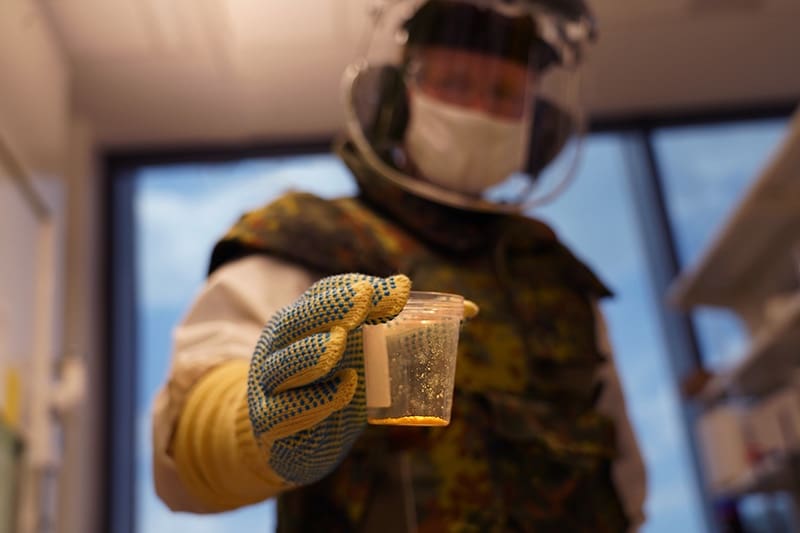
Matthew Gettings, a Purdue Ph.D. candidate, holds a cup containing silver salts, a new lead-free explosive. (Purdue University photo/Jared Pike)
When a gun trigger is pulled, a metal firing pin strikes a cup containing a primary explosive. The force from the firing pin deforms the cup, crushing the primary explosive and causing it to detonate. This explosion sets off a secondary explosive that burns and helps complete the rest of the firing sequence, accelerating the bullet out of the gun.
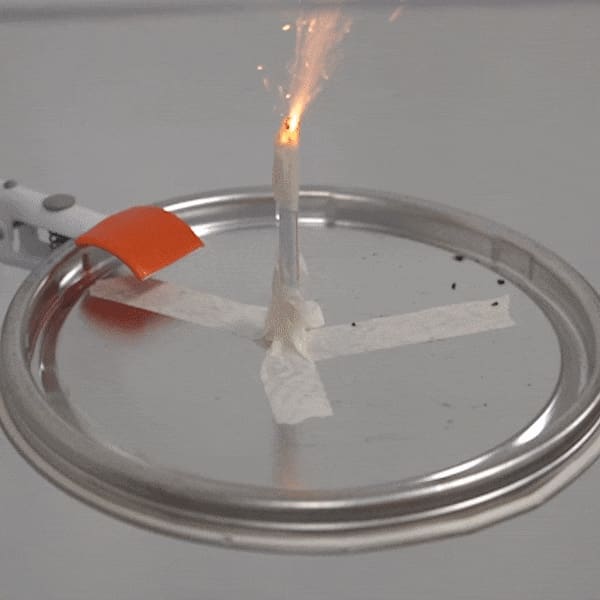
An experimental test shows the ability of silver salts to detonate just as well as commonly-used primary explosives. (Purdue University video/Jared Pike)
Because primary explosives are found in the cartridge of just about anything that fires a bullet, the Army has been searching for solutions for many years to develop lead-free versions of these explosives that satisfy environmental regulations associated with lead contamination.
“The development of these materials provides a potential pathway toward lead-free technology,” said Jesse Sabatini, an Army researcher who led the project’s investigation of which molecules to use for these new materials.
What enables the materials to be lead-free is a chemical structure that has not been used in primary explosives before. One material is made of silver salts while the other material contains no metal at all – just the basic ingredients for an explosive. These ingredients include carbon, hydrogen, nitrogen and oxygen.
“Toxicity-wise, silver is an improvement over lead, but it’s still a little toxic. So we also made a nonmetal material that does not have heavy metal toxicity associated with it. Metal is dead weight, energetically speaking, and doesn’t contribute much to an actual explosion,” Piercey said.
The chemical structure used in these materials makes them very dense, meaning that only a small amount of either material would be needed to create an explosion.
Researchers at the Army Research Laboratory modeled these materials to get a sense of how explosive they would be. Piercey’s lab at the Purdue Energetics Research Center (PERC) made the materials and conducted experimental tests demonstrating that they work as primary explosives.
According to the researchers’ calculations, the materials they created have a detonation performance similar to or higher than commonly-used primary explosives.
The CCDC-Armaments Center at Picatinny Arsenal, New Jersey, is interested in exploring these compounds for primary explosive-based applications for bullets and gun propellants. Purdue and Army researchers will continue to gather the data needed for determining which lead-based weapons systems these materials can replace.
“At PERC, our theme is ‘molecules to munitions.’ Our labs can do everything from designing and testing molecules to formulating and manufacturing those molecules into a useful compound,” said Steve Beaudoin, director of PERC and a Purdue professor of chemical engineering.
“Our partners can then take that useful compound and put it into a warhead, missile, rocket or whatever it needs to be.”
A provisional patent has been filed for this technology (track code 2020-PIER-69143) through the Purdue Research Foundation Office of Technology Commercialization.
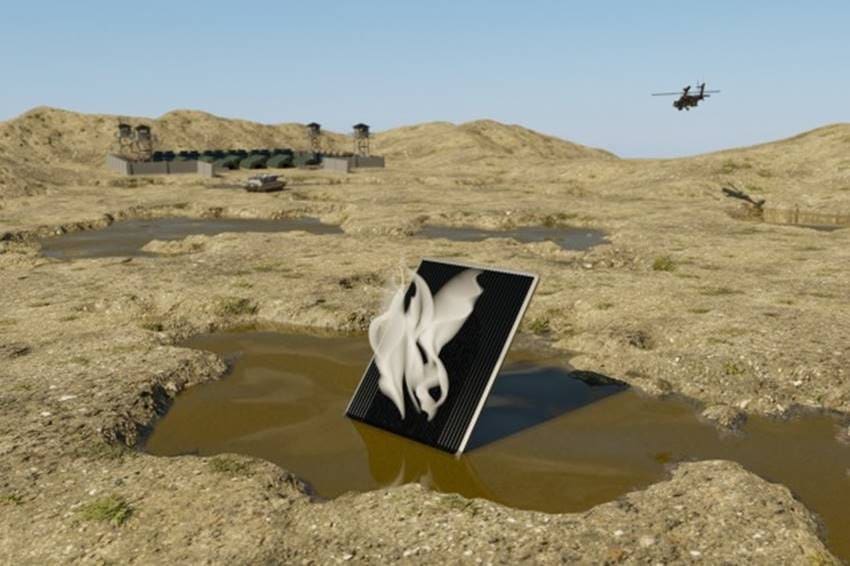
RESEARCH TRIANGLE PARK, N.C. (July 13, 2020) – Providing clean water to Soldiers in the field and citizens around the world is essential, and yet one of the world’s greatest challenges. Now a new super-wicking and super-light-absorbing aluminum material developed with Army funding could change that.
With funding from the Army Research Office, an element of the U.S. Army Combat Capabilities Development Command’s Army Research Laboratory, researchers at the University of Rochester have developed a new aluminum panel that more efficiently concentrates solar energy to evaporate and purify contaminated water.
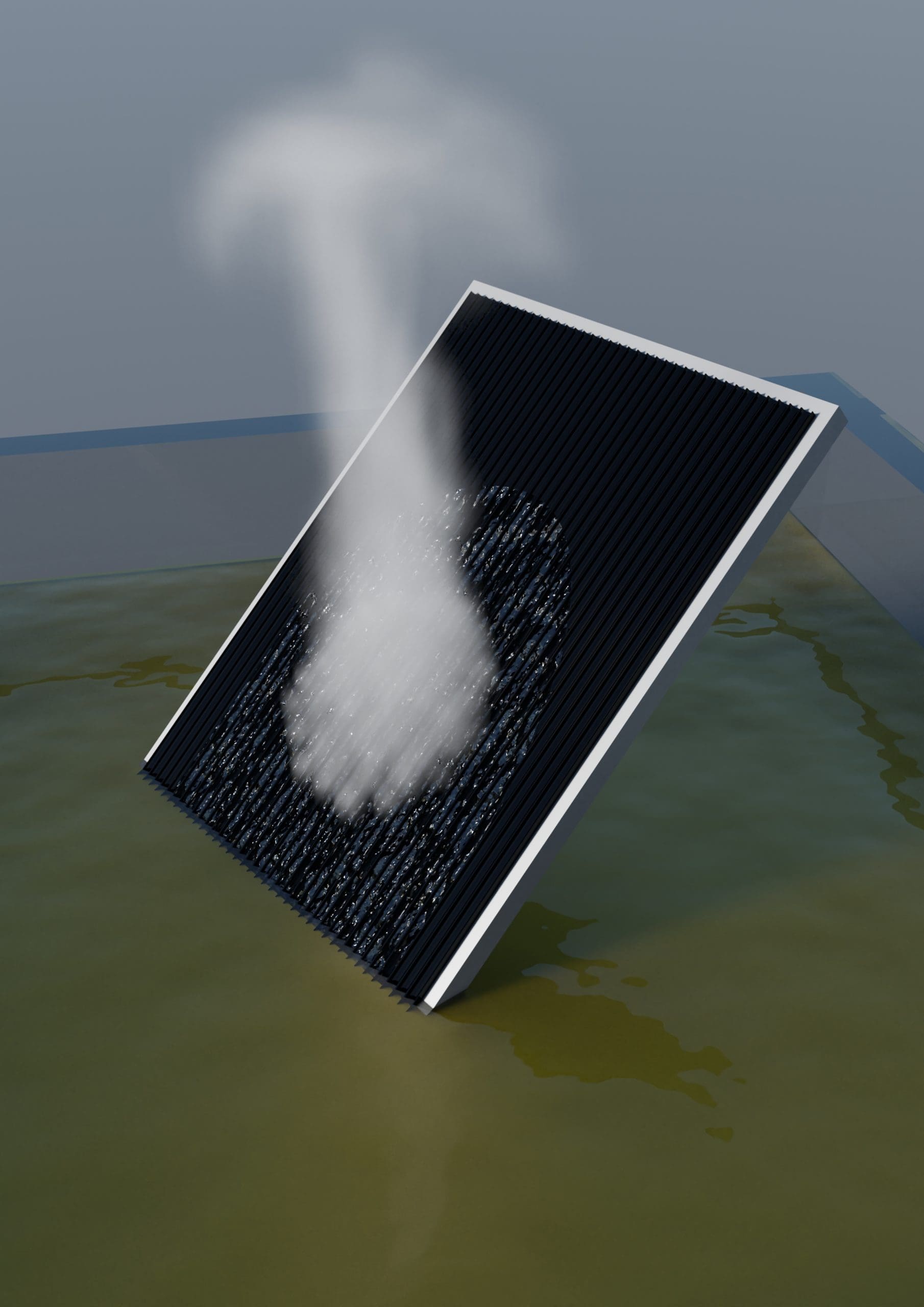
“The Army and its warfighters run on water, so there is particular interest in basic materials research that could lead to advanced technologies for generating drinking water,” said Dr. Evan Runnerstrom, program manager at ARO. “The combined super-wicking and light-absorbing properties of these aluminum surfaces may enable passive or low-power water purification to better sustain the warfighter in the field.”
The researchers developed a laser processing technology that turns regular aluminum pitch black, making it highly absorptive, as well as super-wicking (it wicks water uphill against gravity). They then applied this super absorptive and super-wicking aluminum for this solar water purification.

The technology featured in Nature Sustainability, uses a burst of femtosecond (ultrashort) laser pulses to etch the surface of a normal sheet of aluminum. When the aluminum panel is dipped in water at an angle facing the sun, it draws a thin film of water upwards over the metal’s surface. At the same time, the blackened surface retains nearly 100-percent of the energy it absorbs from the sun to quickly heat the water. Finally, the wicking surface structures change the inter-molecular bonds of the water, increasing the efficiency of the evaporation process even further.

“These three things together enable the technology to operate better than an ideal device at 100 percent efficiency,” said Professor Chunlei Guo, professor of optics at University of Rochester. “This is a simple, durable, inexpensive way to address the global water crisis, especially in developing nations.”
Experiments by the lab show that the method reduces the presence of all common contaminants, such as detergent, dyes, urine, heavy metals and glycerin, to safe levels for drinking.
The technology could also be useful in developed countries for relieving water shortages in drought-stricken areas, and for water desalinization projects, Guo said.

Using sunlight to boil has long been recognized as a way to eliminate microbial pathogens and reduce deaths from diarrheal infections, but boiling water does not eliminate heavy metals and other contaminants.
Solar-based water purification; however, can greatly reduce these contaminants because nearly all the impurities are left behind when the evaporating water becomes gaseous and then condenses and gets collected.
The most common method of solar-based water evaporation is volume heating, in which a large volume of water is heated but only the top layer can evaporate. This is obviously inefficient, Guo said, because only a small fraction of the heating energy gets used.
A more efficient approach, called interfacial heating, places floating, multi-layered absorbing and wicking materials on top of the water, so that only water near the surface needs to be heated. But the available materials all have to float horizontally on top of the water and cannot face the sun directly. Furthermore, the available wicking materials become quickly clogged with contaminants left behind after evaporation, requiring frequent replacement of the materials.
The aluminum panel the researchers developed avoids these difficulties by pulling a thin layer of water out of the reservoir and directly onto the solar absorber surface for heating and evaporation.
“Moreover, because we use an open-grooved surface, it is very easy to clean by simply spraying it,” Guo said. “The biggest advantage is that the angle of the panels can be continuously adjusted to directly face the sun as it rises and then moves across the sky before setting – maximizing energy absorption.”
The Army and Guo are exploring transition opportunities to further develop this technology within DOD laboratories and private industry.
In addition to the Army, this research received funding from the Bill and Melinda Gates Foundation and the National Science Foundation.
By U.S. Army CCDC Army Research Laboratory Public Affairs
Photos courtesy of University of Rochester.

Los Angeles, June 30th, Epirus Inc. received a Small Business Innovation Research Phase Two contract to develop a directed energy prototype for the US Navy. The system will support efforts to deploy non-kinetic capabilities for stopping nefarious vehicles or vessels. This increases stand-off ranges for US service members performing security missions, and minimizes collateral damage caused by other methods such as lasers or small arms.
“This win helps validate Epirus’ approach and advances directed energy technology into the digital age. Challenging the status quo of directed energy has been an uphill battle, but I’m glad to see the work of our engineering teams pay off by providing new data and demonstrated capability,” said Bo Marr, Chief Technology Officer at Epirus.
“Whether it’s checkpoint activities or performing a vehicle interdiction, things can get real dangerous real quick in close quarters with potentially hostile motorists. Increasing stand-off ranges is always a plus for operators on the ground,” commented Aaron Barruga, Epirus team member and Special Forces combat veteran.
Epirus’ approach to electromagnetic pulse utilizes commercial semiconductor technology to deliver unprecedented reduction in size and weight. Their flagship product—Leonidas—delivers a counter drone capability and is also in development for the Department of Defense.